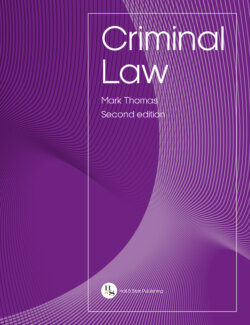Читать книгу Criminal Law - Mark Thomas - Страница 58
На сайте Литреса книга снята с продажи.
2.1.2Identifying the ‘three Cs’
ОглавлениеAs we identified in Chapter 1, the actus reus can be composed not simply of a defendant’s acts or conduct, but also of certain surrounding circumstances and consequences. These elements work together to create the necessary external elements of an offence (see Robinson and Grall, ‘Element Analysis in Defining Criminal Liability: The Model Penal Code and Beyond’ (1983) 35 Stan L Rev 681). For a detailed account of what each of the ‘three Cs’ means, please refer back to Chapter 1.
Using the above example in relation to common assault, the following elements of the actus reus can be identified.
Table 2.2Identifying the ‘three Cs’ in assault
| Actus reus element | Three Cs |
| An act | Conduct |
| Which causes another person | Circumstances |
| To apprehend the infliction of immediate, unlawful force | Consequences |
It is essential that these key elements are identified at an early stage to satisfy the requirement for the actus reus of the offence. Not all offences will include the three Cs; for example, conduct-only crimes (see 2.3.1) require no consequence to exist. Take the offence of theft, for example.
Table 2.3Identifying the ‘three Cs’ in theft
| Actus reus element | Three Cs |
| Appropriation | Conduct |
| Of property | Circumstances |
| Belonging to another | Circumstances |
As you will see in Chapter 11, there is no requirement for there to be a ‘stealing’ in the ordinary sense of the word for the offence of theft to exist. The defendant must possess an intention to permanently deprive the individual of their property (a part of the mens rea of the offence), but there is no requirement in the actus reus for the individual to actually be deprived of the property.
The remainder of the chapter will now go on to consider the meaning of actus reus, its extent and specific applications of the principle.
